On the map above:
blue: places to visit that are not section 482
purple: section 482 properties
red: accommodation
yellow: less expensive accommodation for two
orange: “whole house rental” i.e. those properties that are only for large group accommodations or weddings, e.g. 10 or more people.
green: gardens to visit
grey: ruins
Munster’s counties are Clare, Cork, Kerry, Limerick, Tipperary and Waterford.
For places to stay, I have made a rough estimate of prices at time of publication:
€ = up to approximately €150 per night for two people sharing (in yellow on map);
€€ – up to approx €250 per night for two;
€€€ – over €250 per night for two.
For a full listing of accommodation in big houses in Ireland, see my accommodation page: https://irishhistorichouses.com/accommodation/

donation
Help me to pay the entrance fee to one of the houses on this website. This site is created purely out of love for the subject and I receive no payment so any donation is appreciated!
€15.00
Kerry:
1. Derrynane House, Caherdaniel, County Kerry – OPW
2. Derreen Gardens, Lauragh, Tuosist, Kenmare, Co. Kerry – section 482, garden only
3. Dhu Varren garden, Knockreigh, Milltown, Kerry, V93 VX27
4. Kells Bay House & Garden, Kells, Caherciveen, County Kerry – section 482, garden only
5. Killarney House, County Kerry
6. Knockreer House and Gardens, County Kerry
7. Listowel Castle, County Kerry – OPW
8. Muckross House, Killarney, County Kerry – open to visitors
9. Ross’s Castle, Killarney, County Kerry
10. Staigue Fort, County Kerry
11. Tarbert House, Tarbert, Co. Kerry – section 482
Places to Stay, County Kerry:
1. Ard na Sidhe Country House, Killarney, County Kerry
2. Ballyseede Castle/ Ballyseedy (Tralee Castle), Tralee, County Kerry – hotel, €€
3. Barrow House, Barrow West, Ardfert, Tralee, Kerry, V92 Y270
4. Cahernane (or Cahirnane) House, Killarney, County Kerry – hotel
5. Carrig Country House, County Kerry €€€
6. Castlemorris House, Tralee, County Kerry
7. Dromquinna Estate, County Kerry – €€
8. Fahagh Court, Beaufort, County Kerry – now Killarney Country Club and accommodation €
9. Glanleam, Valentia Island, County Kerry – accommodation €
10. Keel House, Keel, Castlemaine, Co. Kerry V93 A6 Y3
11. Kells Bay House & Garden, Kells, Caherciveen, County Kerry €
12. Muxnaw Lodge, Kenmare, County Kerry €
13. Parknasilla Resort and Spa, Kenmare, County Kerry
Whole House Rental County Kerry:
1. Ballywilliam House, Kinsale, County Kerry – whole house rental, up to 16
2. Barrow House, Barrow West, Ardfert, Tralee, Kerry, V92 Y270
3. Churchtown House, Killarney, County Kerry – whole house rental (sleeps 12)
4. Coolclogher House, Killarney, County Kerry – whole house rental (up to 16 people)
Places to visit in County Kerry:
1. Derrynane House, Caherdaniel, Kerry – OPW

See my OPW write-up: https://irishhistorichouses.com/2022/11/07/office-of-public-works-properties-in-munster-counties-kerry-and-waterford/

2. Derreen Gardens, Lauragh, Tuosist, Kenmare, Co. Kerry – section 482, garden only
https://www.derreengarden.com/
Open dates in 2025: all year, 10am-6pm
Fee: adult/OAP/student €10, child €5, family ticket €30 (2 adults & all accompanying children under18) 20% discount for groups over 10 people
See my entry https://irishhistorichouses.com/2023/09/07/derreen-gardens-lauragh-tuosist-kenmare-co-kerry/
The website tells us: “A beautiful 19th century woodland garden with paths winding through rare tropical plants and opening onto sea views.

“Set on a peninsula at the head of Kilmackillogue Harbour and surrounded by the Caha Mountains, the garden at Derreen covers 60 acres.
“A network of winding paths passes through a mature woodland garden laid out 150 years ago with subtropical plants from around the world and incomparable views of the sea and mountains.“
3. Dhu Varren garden, Knockreigh, Milltown, Kerry, V93 VX27
The website tells us:
“Dhu Varren Garden, owned by Mark and Laura Collins, began its development in 2001. Since then it has grown to contain one of the largest and most diverse plant collections of any private garden in Ireland. This continues to grow as new and exciting plants are sourced from around the world. It has been described by visitors as ‘Kerry’s Botanical Garden’.“
4. Kells Bay House & Garden, Kells, Caherciveen, Co Kerry, V23 EP48 – section 482, garden only
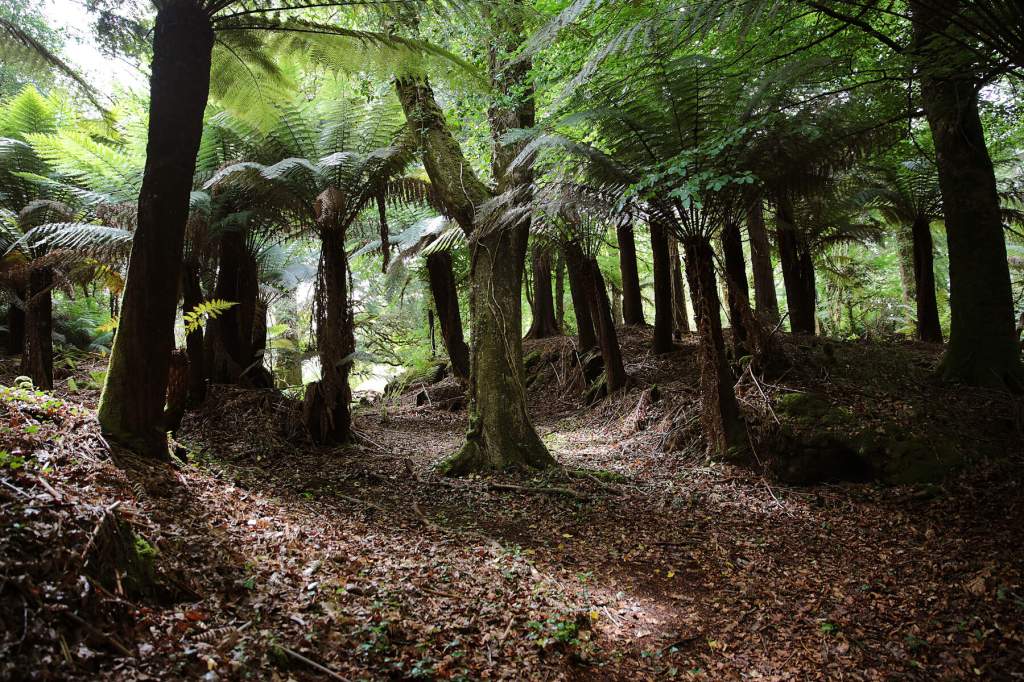
Open in 2025: Jan 1-4, Feb 1-Dec 21, 27-31, Jan-Apr, Oct-Dec 9am-5pm, May-Sept 9am-6pm
Fee: adult €9.50, child €7.50, family €30 (2 adults and up to 3 children 17 years or under) concessions 10% on groups up to 20 persons
See my entry https://irishhistorichouses.com/2023/09/13/kells-bay-house-garden-kells-caherciveen-county-kerry/
The website tells us: “Kells Bay Gardens is one of Europe’s premier horticultural experiences, containing a renowned collection of Tree-ferns and other exotic plants growing in its unique microclimate created by the Gulf Stream. It is the home of ‘The SkyWalk’ Ireland’s longest rope-bridge.“
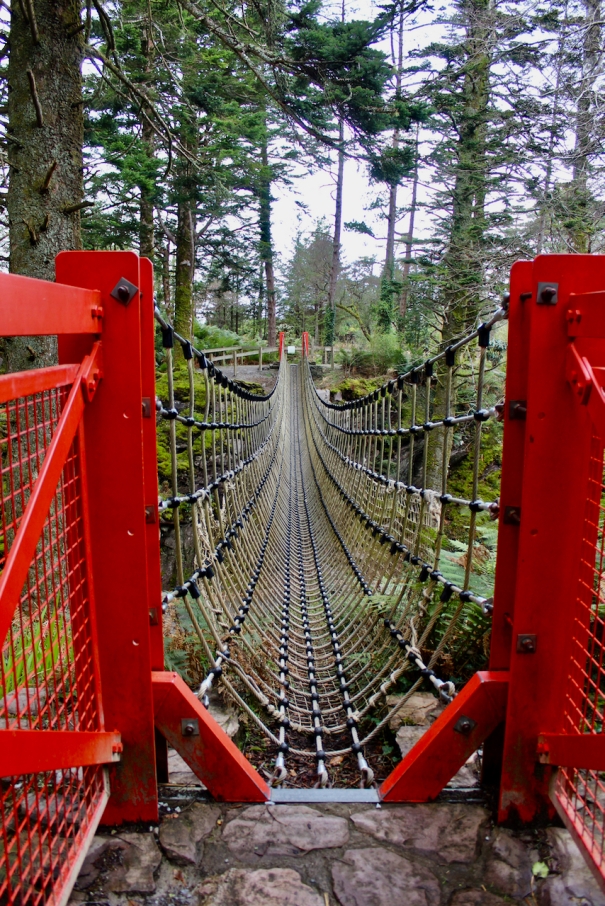
5. Killarney House, County Kerry
https://killarney.ie/listing/killarney-house-gardens/
Originally called Kenmare House. The stable block of Kenmare House was converted in 1830 into this house. The original Kenmare House was built in 1726 and was demolished in 1872 by Valentine Augustus Browne, 4th Earl of Kenmare. The succeeding house, called Killarney House, and was accidentally destroyed by fire in 1913 and never rebuilt; instead, in 1915 the stable block of the original Kenmare House was converted into the present Killarney House, although the Brownes called it Kenmare House.
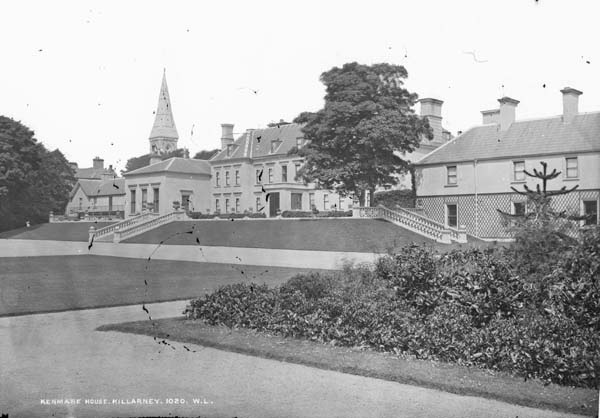

John McShain, renowned architect and building contractor, acquired Killarney House, the former home of the Earls of Kenmare, in 1956. After the death of McShain’s wife, Mary, in 1998, the stately house, and its lavish gardens were sold to the State with the proviso that the property would be incorporated into the neighbouring Killarney National Park. The McShains were allowed to live in the house for the remainder of their lives, and they remodelled extensively. When Mrs. McShain died in 1998 the house reverted to the state. It sat empty and became derelict, but in 2011 restoration was begun. The gardens are open to the public and at some stage, the house also will be opened up.
6. Knockreer House and Gardens, County Kerry
https://www.discoverireland.ie/kerry/knockreer-house-and-gardens
The website tells us:
“Found in County Kerry’s Killarney National Park, Knockreer House and Gardens are within walking distance of Killarney Town. The area includes a circular walk with excellent views of the Lower Lake.
“The Knockreer section of Killarney National Park is within walking distance of Killarney Town, County Kerry. This area was formerly part of the Kenmare Estate, which was laid out by Valentine Brown, the third Viscount of Kenmare. Deenagh Lodge Tearoom dates back to 1834 and was the gate lodge of the Kenmare Estate. The tearoom is a popular haunt with locals and visitors after a stroll in the park. It is located just inside Kings Bridge across from St Mary’s Cathedral.
“Knockreer House, a short walk up the hill, is the Killarney National Park Education Centre and is built on the site of the original Killarney House, which was destroyed by fire in 1913. The circular walk is signposted and offers excellent views of the Lower Lake. On the circular walk there is a pathway off to the right that leads up to the viewing point on top of the hill, which provides a wonderful panorama of the surrounding countryside.“
7. Listowel Castle, County Kerry – OPW
See my OPW write-up: https://irishhistorichouses.com/2022/11/07/office-of-public-works-properties-in-munster-counties-kerry-and-waterford/
8. Muckross House (or Muckruss), Killarney, County Kerry
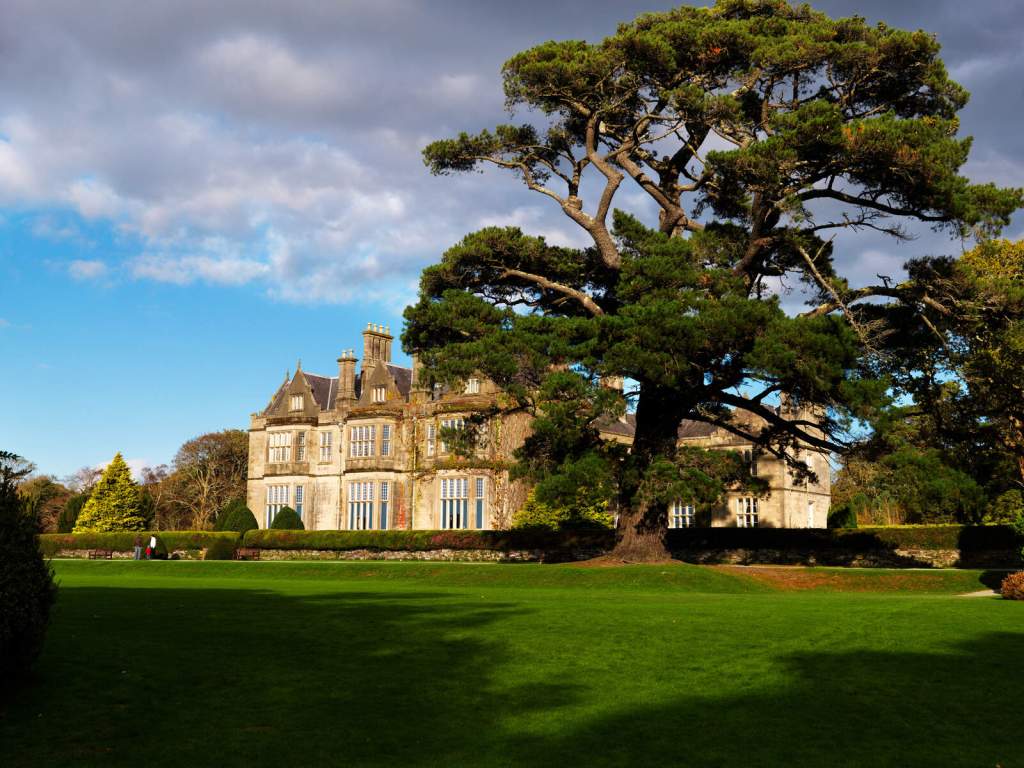
“This nineteenth century Victorian mansion is set against the stunning beauty of Killarney National Park. The house stands close to the shores of Muckross Lake, one of Killarney’s three lakes, famed world wide for their splendour and beauty. As a focal point within Killarney National Park, Muckross House is the ideal base from which to explore this landscape.
“Muckross House was built for Henry Arthur Herbert and his wife, the water-colourist Mary Balfour Herbert. This was actually the fourth house that successive generations of the Herbert family had occupied at Muckross over a period of almost two hundred years. William Burn, the well-known Scottish architect, was responsible for its design. Building commenced in 1839 and was completed in 1843.
“Originally it was intended that Muckross House should be a larger, more ornate, structure. The plans for a bigger servants’ wing, stable block, orangery and summer-house, are believed to have been altered at Mary’s request. Today the principal rooms are furnished in period style and portray the elegant lifestyle of the nineteenth century landowning class. In the basement, one can imagine the busy bustle of the servants as they went about their daily chores. “
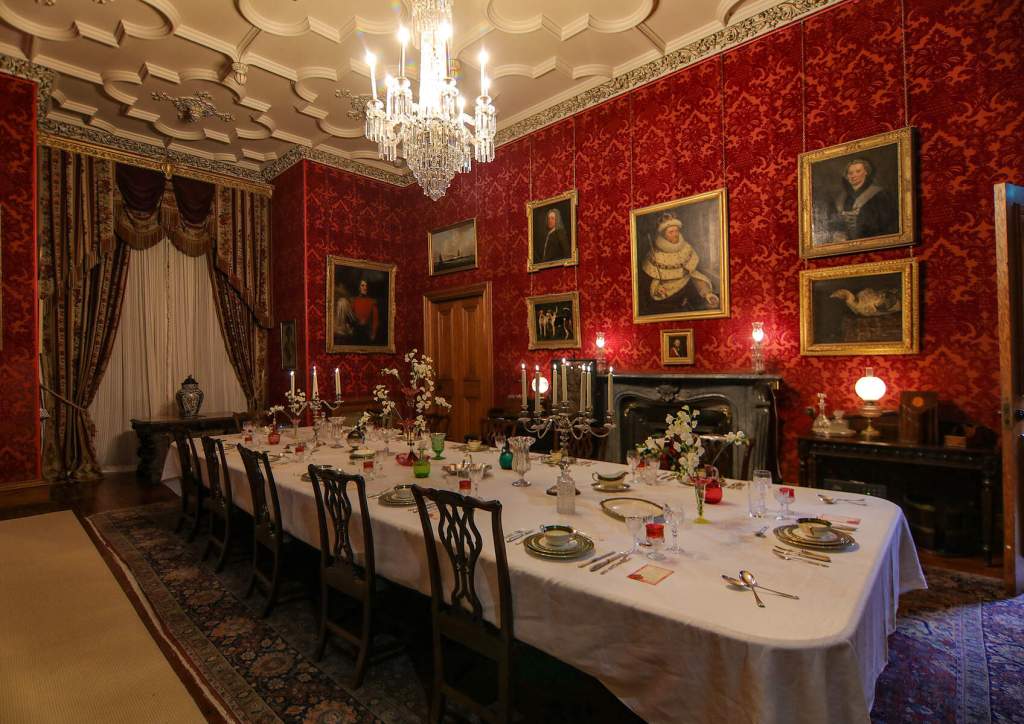

“During the 1850s, the Herberts undertook extensive garden works in preparation for Queen Victoria’s visit in 1861. Later, the Bourn Vincent family continued this gardening tradition. They purchased the estate from Lord and Lady Ardilaun early in the twentieth century. It was at this time that the Sunken Garden, Rock Garden and the Stream Garden were developed.“
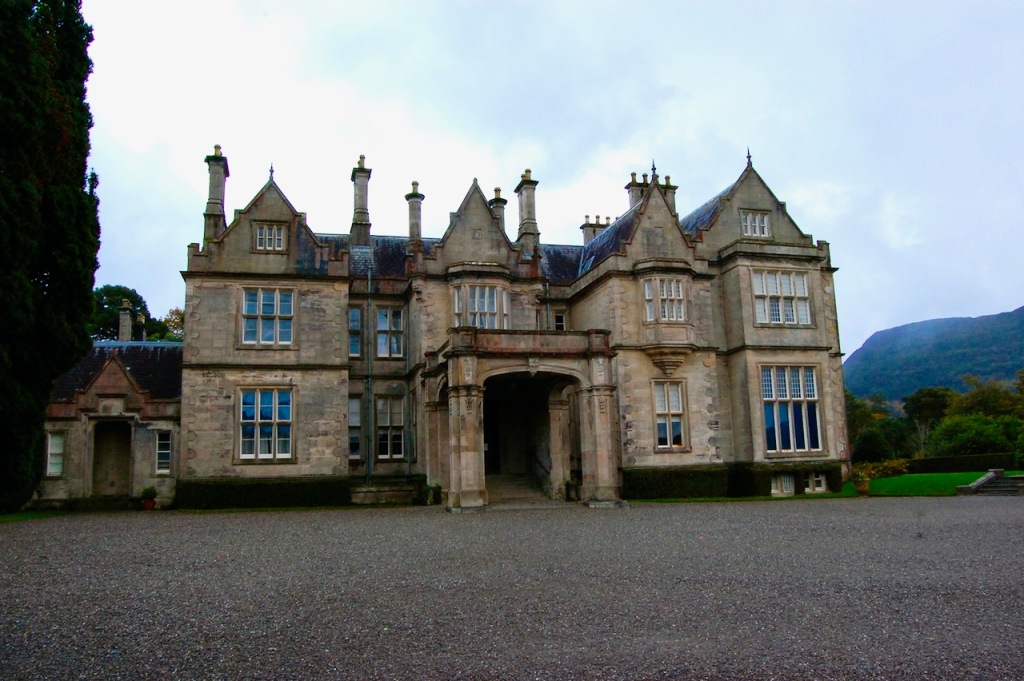
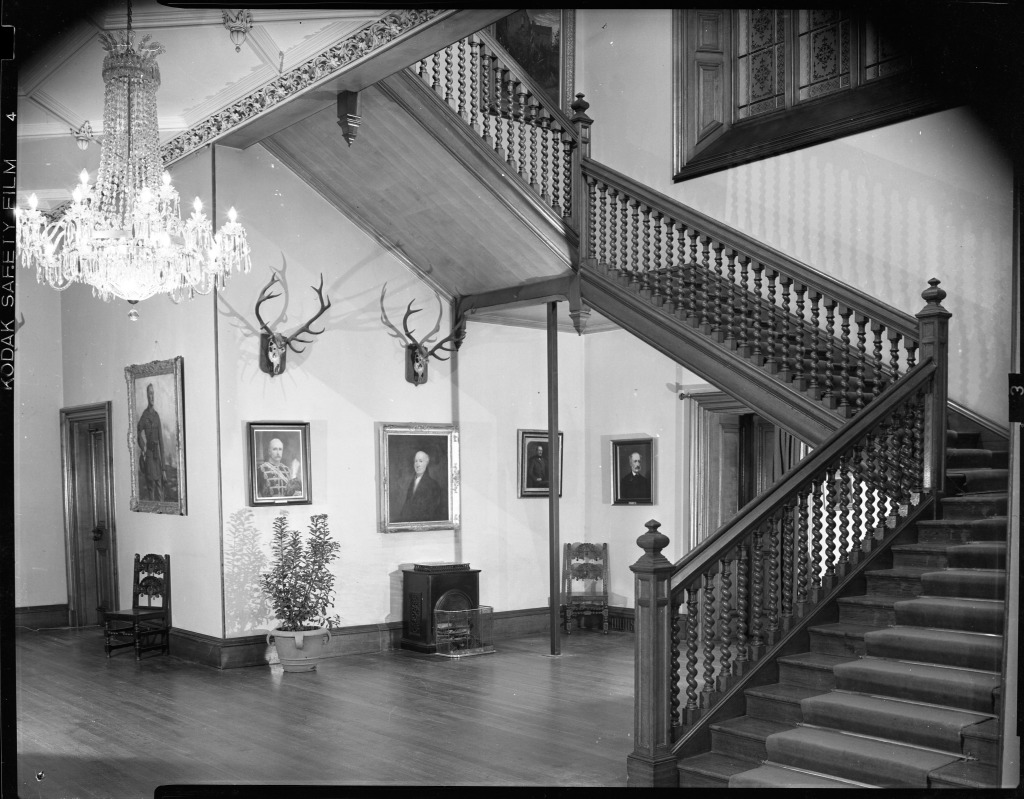

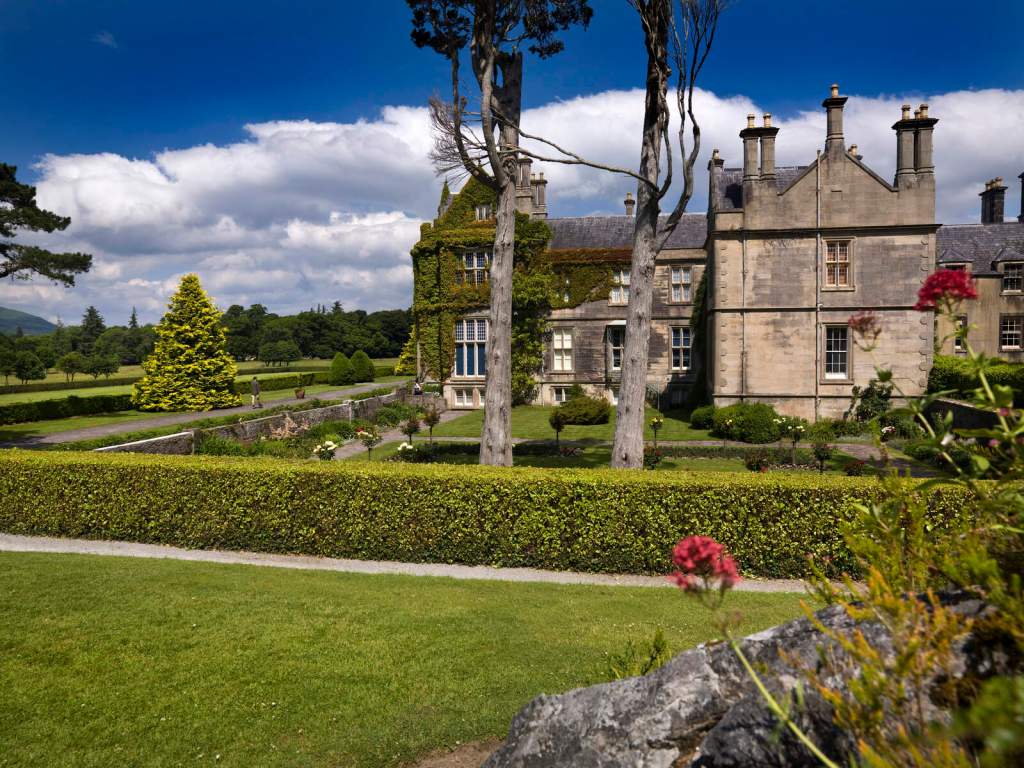


9. Ross’s Castle, Killarney, County Kerry
See my OPW write-up: https://irishhistorichouses.com/2022/11/07/office-of-public-works-properties-in-munster-counties-kerry-and-waterford/
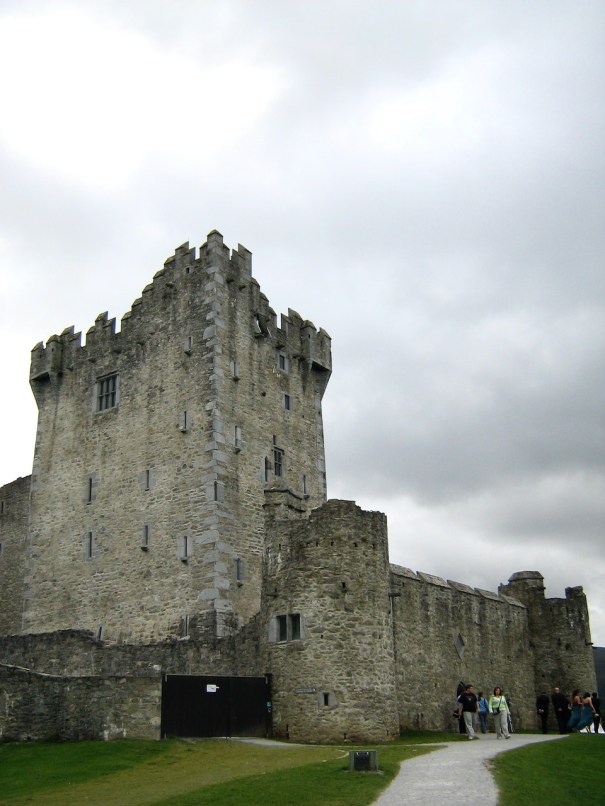
10. Staigue Fort, County Kerry
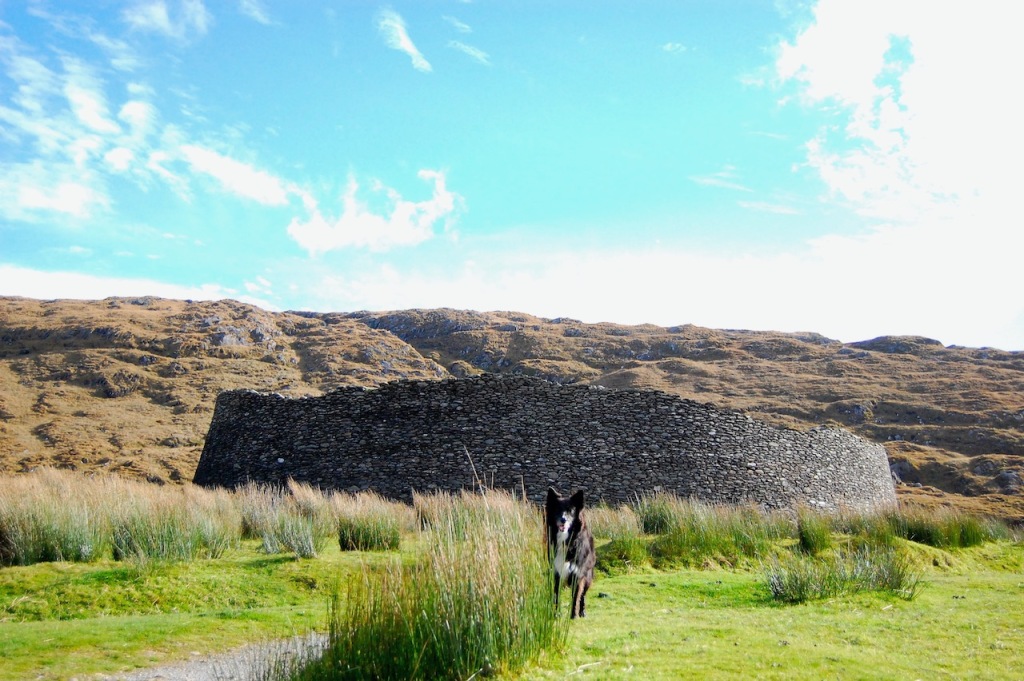
The following website gives us information about this ancient impressive fort: https://voicesfromthedawn.com/staigue-fort/
It tells us:
“Constructed entirely without mortar, Staigue cashel encloses an area of 27.4 m (90 ft) in diameter, with walls as tall as 5.5 m (18 ft) and a sturdy 4 m (13 ft) in thickness. It has one double-linteled entrance, a passageway 1.8 m (6 ft) long. In the virtual-reality environment (above) click the hotspots to proceed to the fort’s interior. It is similar in construction to the Grianan of Aileach in Co. Donegal, and was possibly constructed in the same period of the Early Medieval period (approximately fifth to eleventh century CE). The fort is surrounded by a large bank and ditch, most evident on its northern side. This may have been a part of Staigue’s defenses, or it may be a prehistoric feature that pre-dates the construction of the stone fort.“
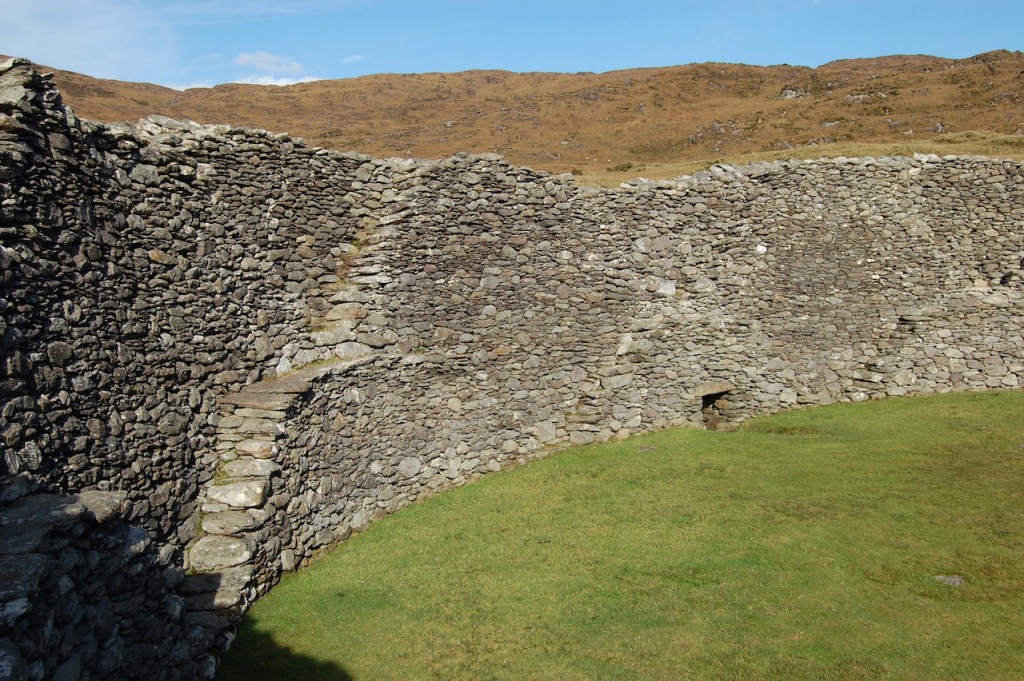
The website continues: “In 1897 T.J. Westropp reported that the local peasantry called the building Staig an air, which he translated as “Windy House, or “Temple of the Father,” or “The Staired Place of Slaughter.” These different translations may inspire distinctly different conjectures about the builders of Staigue. It has been described as both a temple or an observatory, and has been attributed to many different cultures in the past, such as Druids, Phoenicians, Cyclopeans, and Danes. But it was, of course, built by the “Kerrymen of old.”

“The sign at the site explains that Staigue “was the home of the chieftain’s family, guards and servants, and would have been full of houses, out-buildings, and possibly tents or other temporary structures.” The illustration from this sign is in the gallery below. Cashels, of which Staigue is an impressive and probably high-status example, were enclosed and defendable farmsteads of the Irish Early Medieval period. They housed an extended family and, in high-status examples, their retinue. However archaeologist Peter Harbison was unable to explain why the ancient architects would have created so many (10) sets of X-shaped stairs climbing up the inner face of the wall to its ramparts.“
11. Tarbert House, Tarbert, Co. Kerry – section 482
Open dates in 2025: Jan 1-4, 6-11, 13-18, 20-25, 27-31, May 1-3, 5-10, 12-17, 19-24, 26-31, July 1-5, 7-12, 14-19, 21-26, 28-30, Aug 1-2, 4-9, 11-31, 10am-12 noon, 2pm-4pm
Fee: adult/OAP/student €5, child free
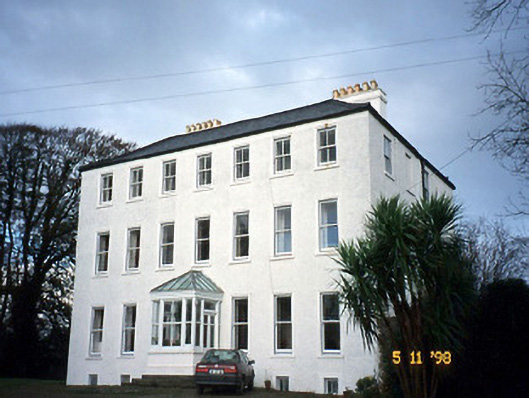
“Tarbert House, near the town of that name in County Kerry, stands in wooded parkland beside the River Shannon, a few miles downstream from Glin and just across the county bounds. The plain, square, seven-bay seat of James Leslie, erstwhile Bishop of Limerick, was built precisely in the middle of his diocese for convenience, and dates from the 1750s. The house, which is still owned by the bishop’s descendants, was given an additional storey in the mid-19th century but retains its mid-Georgian character and plan, with robust joinery and chimneypieces, and a fine collection of family portraits, furniture, papers and objects.” [3]
Places to Stay, County Kerry:
1. Ard Na Sidhe, Killarney, County Kerry
2. Ballyseede Castle, Tralee, Co. Kerry – section 482, also a hotel for accommodation €€
www.ballyseedecastle.com
Open dates in 2025: Mar 14-Dec 31, 8am-12 midnight
Fee: Free to visit.
We treated ourselves to a stay in 2023. See my entry: https://irishhistorichouses.com/2023/09/02/ballyseede-castle-ballyseede-tralee-co-kerry/

3. Barrow House, Barrow West, Ardfert, Tralee, Kerry, V92 Y270
The website https://www.barrowhouse.ie/ tells us the House and Gardens are available for bed & breakfast guests or as an exclusive venue for corporate functions, private group rentals and intimate, small scale weddings. They are members of the Historic Houses of Ireland association, which tells us of the history of the house:
“Nestling on the shore of stunning Barrow Harbour with views of the glorious Slieve Mish Mountains, Barrow House in Co. Kerry has a rich history of ownership from knights to noblemen and smugglers.
“Built in around 1715, it possibly incorporates the fabric of an earlier house from during or after the Cromwellian period (1649-57). The sublime Georgian front elevation of Barrow House was added as part of the structural rebuild and enlargement work carried out at some point before 1760, while a second sympathetic addition was made at the rear towards the end of the 1800s. The house has changed little over the years. In fact, its still-visible four-feet thick internal walls, two gable end chimney stacks, original interior features, handcrafted ceiling mouldings and sash windows with antique glass exude the restrained, rational elegance typical of a noble dwelling.
“Alongside is a detached seven-bay single- and two-storey former boathouse, c. 1800, on a U-shaped plan. Barrow’s lands were originally part of the 6,000 acres granted by Elizabeth 1 in 1587 to Sir Edward Denny for his loyalty following the Desmond Rebellion. Nearby are the ruins of an ancient church referred to in Papal documents 1302-07 as “Ecclesia of Barun” or the Church of Barun (Barrow).
“Over the centuries, the house and the estate were passed on through marriage or by sale to different owners, including the notorious smuggler, John Collis. The smuggling of wines and tobacco was prevalent in Kerry during the 17th and 18th centuries in particular and Barrow Harbour was a natural rendezvous with its caves and narrow inlets. In the first half of the 20th century, the Knights of Kerry, the Fitzgerald family, affectionately referred to Barrow House as their summerhouse. In more recent years, it was purchased by an American, Maureen Erde, who published a popular account of running it as a golfers’ guesthouse entitled “Help me, I’m an Irish Inn Keeper”. After she sold it in 1999, the house was restored as a resort estate, flourishing for some years before enduring a period of neglect and abandonment. Barrow House’s current owner, Daragh McDonagh, purchased it in 2016 and has lovingly restored it to welcome guests.“
4. Cahernane (or Cahirnane) House, Killarney, Co Kerry – hotel
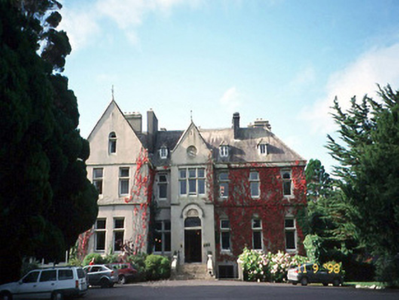
The website tells us:
“Beautifully situated on a private estate on the edge of Killarney National Park, our luxury four-star hotel is located just twenty minutes’ walk from Killarney town centre. The entrance to the hotel is framed by a tunnel of greenery which unfurls to reveal the beauty of this imposing manor house, constructed in 1877 and formerly home to the Herbert Family.
“Cahernane House Hotel exudes a sense of relaxation and peacefulness where you can retreat from the hectic pace of life into a cocoon of calmness and serenity. The only sounds you may hear are the lambs bleating or the birds singing.
“Cahernane House was built as the family residence of Henry Herbert in 1877 at a cost of £5,992. The work was carried out by Collen Brothers Contractors. The original plans by architect James Franklin Fuller, whose portfolio included Ballyseedy Castle, Dromquinna Manor and the Parknasilla Hotel, was for a mansion three times the present size.“
5. Carrig Country House, County Kerry €€€
The website tells us: “If you are looking for the perfect hideaway which offers peace, tranquility, plus a wonderful restaurant on the lake, Carrig House on the Ring of Kerry and Wild Atlantic Way is the place for you. The beautifully appointed bedrooms, drawing rooms and The Lakeside Restaurant, overlooking Caragh Lake and surrounded by Kerry’s Reeks District mountains, rivers and lakes create the perfect getaway.
“Carrig House was built originally circa 1850 as a hunting lodge, it was part of the Blennerhassett Estate. It has been mainly owned and used by British Aristocracy who came here to hunt and fish during the different seasons.
“The house was purchased by Senator Arthur Rose Vincent in the early 20th. Century. Vincent moved here after he and his wealthy Californian father in law Mr. Bowers Bourne gave Muckross House & Estate in Killarney to the Irish Government for a wonderful National Park.
“Bourne had originally purchased Muckross House from the Guinness family and gave it to his daughter Maud as a present on her marriage to Arthur Rose Vincent. However, Maud died at a young age prompting Bourne and Vincent to donate the estate to the Irish State.
“Vincent remarried a French lady and lived at Carrig for about 6 years, they then moved to the France. The country house history doesn’t end there, Carrig has had many other illustrious owners, such as Lady Cuffe , Sir Aubrey Metcalfe, who retired as the British Viceroy in India and Lord Brocket Snr, whose main residence was Brocket Hall in England.
“Frank & Mary Slattery, the current owners purchased the house in 1996. They are the first Irish owners of Carrig since it was originally built and have renovated and meticulously restored the Victorian residence to its former glory.
“For over two decades Frank & Mary have operated a very successful Country House & Restaurant and have won many rewards for their hospitality and their Lakeside Restaurant. They are members of Ireland’s prestigious Blue Book.
“Carrig House has 17 bedrooms, each individually decorated in period style with antique furniture. Each room enjoys spectacular views of Caragh Lake and the surrounding mountains. All rooms are en suite with bath and shower. Those who like to indulge can enjoy the sumptuous comfort of the Presidential Suite with its own separate panoramic sitting room, male and female dressing rooms and bathroom with Jacuzzi bath.
“The restaurant is wonderfully situated overlooking the lake. The atmosphere is friendly, warm and one of total relaxation. The menu covers a wide range of the freshest Irish cuisine.
“Irish trout and salmon from the lake and succulent Kerry lamb feature alongside organic vegetables. Interesting selections of old and new world wines are offered to compliment dinner whilst aperitifs and after-dinner drinks are served in the airy drawing room beside open peat fires.
“Within the house, chess, cards and board games are available in the games room.“
6. Castlemorris House, Tralee, County Kerry €
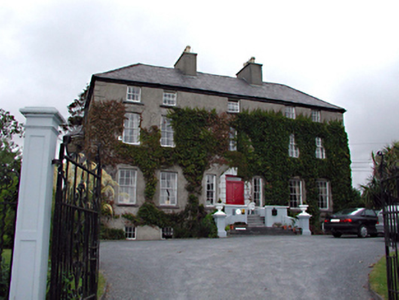
https://www.bandbireland.com/accommodation/28161/castlemorris-house
Castlemorris is now a bed and breakfast. The National Inventory tells us it is a detached five-bay three-storey over basement house, built c. 1830, with single- and two-storey extensions to rear. Formerly residence of army officer in neighbouring barracks.
7. Dromquinna Estate, Co Kerry €€
https://www.dromquinnamanor.com

It was constructed for Sir John Columb around 1889-90. The website tells us:
“There are many elements to Dromquinna Manor. Firstly it is a stunning waterside estate unlike anything else. Set on 40 acres of parkland planted in the 1800s, the Estate offers an abundance of activities and facilities.
“The Manor, dating from the 1890s, is dedicated to catering for Weddings and events. The Oak Room is the heart of the Manor and is classical in every sense. Stylish beyond words with views of Kenmare Bay celebrations here are truly memorable. The Drawing Rooms and Terrace all make for a very special and memorable occassion for all. It is a real family and friends party as opposed to a hotel ballroom function.”
8. Killarney Country Club cottage (formerly Fahagh Court) Beaufort, Co Kerry €
Mark Bence-Jones tells us about the main house (1988): p. 122. (Morrogh-Bernard/IFR) An irregular two storey house with a shallow battlemented bow and a rusticated doorcase of sandstone on its front, and a gable at the back. Now an hotel.” [4]
On airbnb https://www.airbnb.ie/rooms/18733691?source_impression_id=p3_1652716587_lWafOPgeB9uWaPDl
The website tells us:
“A fantastic mid-terrace property in the grounds of Killarney Country Club just outside Faha near Beaufort in County Kerry, eight miles from Killarney.
“Stone built but with a modern feel and fantastic mountain views, this is an excellent base for a family or friends to come to County Kerry and do some sightseeing.
“There are two bedrooms upstairs, a double and a twin, along with a shower room, while on the ground floor there is an open plan living area with kitchen, dining area and living area, keeping everyone together while breakfast is being rustled up ahead of a day of exploring.
“French doors in the living area take you out to the rear garden, with spectacular views of Macgillycuddy’s Reeks mountain range, home to Carrauntoohil, the highest peak in Ireland.
“With a bar on site there will be no arguments about who the designated driver will be.
“With great scenery in the surrounding area, be sure to do a bit of sightseeing while out for a walk or a cycle in the fresh Irish air.
“Only a short drive down the road, Beaufort will tend to your basic needs while Killarney is only eight miles away, where you can sample a range of shops, restaurants and pubs with some good local Irish music being played.“
9. Glanleam, Valentia Island, Co Kerry €
https://hiddenireland.com/house-pages/glanleam-house/
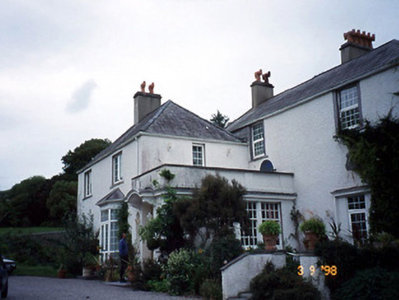
The website tells us:
“Glanleam was built as a linen mill in 1775 and later converted into a house by the Knight of Kerry, who planted the magnificent sub-tropical gardens. In 1975 Meta Kreissig bought the estate which had declined for 50 years. She rescued the house, restored and enlarged the garden and, with her daughter Jessica, made it a delightful place to stay, with a mixture of antique and contemporary furniture and an extensive library. The setting looking out over the harbour is magical. There are green fields, a beach and a lighthouse, and Valentia Island is connected to the Kerry mainland by a car ferry and a bridge.
“Glanleam was converted into a country house by the 19th Knight of Kerry (1808-1889). His father had developed the famous Valentia slate quarry (the slates were especially in demand for billiard tables, then very much in vogue). The Knight, an enthusiastic botanist, recognised the unique potential of the island’s microclimate for sub-tropical plants and laid out a fifty acre garden, using species just introduced from South America. His efforts won him great acclaim at the time and today his gardens have matured into dense woodlands.
“Together Meta Kreissig and her daughter Jessica have refurbished the house, furnishing it with an amalgam of antique and modern pieces, and opened it to guests. There is an extensive library, several of the rooms have their original Valentia slate chimneypieces, and the bedrooms have luxurious Bonasck designer bathrooms. The gardens have also benefited from their attention. One recent visitor described the ‘radial planting of vegetables’ in the centre of the walled kitchen garden as ‘a jewel’.“
10. Keel House, Keel, Castlemaine, Co. Kerry V93 A6 Y3
(Tourist Accommodation Facility)
Open for accommodation in 2025: April 1- Sept 30
https://www.airbnb.ie/rooms/763099850152850482?source_impression_id=p3_1741194866_P3bysbQjjoOVpVMf
11. Kells Bay House & Garden, Kells, Caherciveen, Co Kerry € see above
https://www.kellsbay.ie/accommodation/
12. Muxnaw Lodge, Kenmare, Co Kerry €
https://www.muxnawlodgekenmare.com/
The website tells us that Muxnaw Lodge in Kenmare is an attractive Victorian house, with spectacular views of the Kenmare River and Suspension Bridge.
Muxnaw Lodge features in Jane O’Hea O’Keeffe’s Voices from the Great Houses: Cork and Kerry. Mercier Press, Cork, 2013:
p. 242. “John Desmond Calverley Oulton (konwn as Desmond), who was born at Clontarf Castle in 1921, is the son of John George Oulton and Sybil Mona Calverley. He has long and loving memories of his childhood home at Clontarf Castle, where he played with his siblings in truly magical surroundings…”
p. 245. “During his childhood days, Desmond and his family would travel to Kerry each summer to stay at Muxnaw Lodge at Kenmare, which had been owned for generations by his mother’s people, the Calverleys. A lovely gabled building, the Lodge was built in 1801 as a hunting and fishing lodge by the Calverley family. It is situated on a spectacular site overlooking the Kenmare River and is now run as an up-market guesthouse.
The name Muxnaw comes from the Irish Mucsnamh (the swimming place of the pigs). Joyce’s Irish Place Names gives this explanation:
“The natural explanation seems to be that wild pigs were formerly in the habit of crossing… at this narrow point. The Kenmare River narrowed at this point by a spit of land projecting from the northern shore, and here in past ages, wild pigs used to swim across so frequently, and in such numbers, that the place was called Muscnamh or Mucksna.”
p. 245. “Desmond explains the complexities of his family history: “Colonel Vernon, owner of Clontarf Castle, had several daughters and a son. One daughter, Edith Vernon, married Walter Calverley who owned Muxnaw Lodge. They had two children, my mother, Sybil Mona Calverley, and Walter Calverley. Walter was killed during the first world war, and following the death of Walter Calverley Sr, Muxnaw Lodge went to his brother, Charles, who left it to his niece, my mother.” “
13. Parknasilla Resort and Spa, Kenmare, Co Kerry

The website tells us:
“Parknasilla Hotel, nestled in the shadows of the Kerry mountains amidst islands, inlets and hidden beaches.
“Come stay with us and feel the restorative power of nature and marvel in the splendour of the seascape and landscape that surrounds you here.
“The word Parknasilla ,(means the field of Sallys) [perhaps “salix” meaning Willow], for so many is evocative of so many things, tucked away in the corner of a subtropical paradise on the Kenmare river , it’s a place of beauty, of rare plants, islands linked by timber bridges and coral inlets.
“Where the sea, the light and clouds put on a continual show to delight the senses. A place where people come as guests and leave as friends, with its tradition of hospitality stretching back over 125 years. It has hosted royalty, dignitaries, family gatherings and romantic get aways.
“It has provided people with that peaceful haven for them to recalibrate and recharge their batteries but it has also been that place of quite inspiration for writers and artist from George Bernard Shaw to Ceclia Ahern .
“With its winding walks, this 200 acre estate walled gardens, golf course, island dotted bay and spa coupled with a world class resort with a 4 star hotel houses and apartments it provides one with that perfect retreat to suit all tastes.
“It is a place of many layers constantly evolving, seen through the prism of history it’s a place where people create their own be it in the friends formed or memories laid down to last a life time, a place to return to again.”
The website tells us about the history of Parknasilla:
“The origins of the rise of the Great Southern Hotels and Parknasilla arised from the middle of the 19th century. Despite the ravages of the famine, Ireland was seen as an exotic tourism destination and this was particularly true after Queen Victoria’s trip to Ireland and Kerry in 1861, that saw an explosion of tourism from overseas. Railway lines were developed in the mid 1850’s from Dubin to remote towns of Killarney, Dingle, Galway and Sligo and later new lines were developed from Killarney for instance to Kenmare.
“In the South of Ireland, the most import railway was the Great Southern and Western Dublin-Cork Link that opened in 1849. Excursions were promoted and resort hotels that were built were to supplied with customers by new railway line. New doors opened for Parknasilla around the start of the 1890’s, when in 1893 Kenmare became the terminuis of the branch line. Subsequently two years earlier, the Derryquin Estate was in 1891 by the Bland family in various lots. Bishop Graves of Limerick who had leased the part of the property for a long period off the Blands, purchased in one lot, and only a short time after sold the property to the Great Southern Hotel Group.
“On the 1st of May 1895, The Southern Hotel Parknasilla opened, the name Parknasilla which means “The field of the willows” began to appear on the maps. It was also refered to as the “Bishops House Hotel, Parknasilla”. The story of the construction of architecture is also an interesting one. Eminent architect James Franklin Fuller was chosen by the Great South and Western Railway, prior 1895. Fuller himself left an incredible legacy behind, he was responsible for the designs of some of Ireland’s most iconic buildings such as Kylemore Abbey, Ashford Castle, Kenmare Park (formely the Great Southern Kenmare) and Farmleigh House.
“Born in 1835 in Kerry, he was the only son of Thomas Harnett Fuller of Glashnacree by his first wife, Frances Diana, a daugther of the Francis Christopher Bland of Parknasilla dn Derryquin Castle. The Blands were indeed synomous with Parknasilla for over two centuries, and new chapter for Parknasilla future now had an incredible link with its past.
“The hotel originally started out in what was known as “The Bishops House”, however a better position was chosen in 1897 for a new purpose buillt hotel. The new Parknasilla Hotel faced down the Kenmare Bay an offered its guests uparelled views of the Atantic Ocean. The facilties of the new hotel included Turkish Hot and Cold Seawater Baths, reading and games rooms and bathrooms on every floor. This decision came after unprecedented demand that well exceed supply.“
The website also tells us about the early owners of the property:
“The Blands of Derryquin Castle Demense were a Yorkshire family, the first of whom Rev. James Bland came to Ireland in 1692 and from 1693 was vicar of Killarney. His son Nathaniel, a judge and vicar general of Ardfert and Aghadoe obtained a grant of land in 1732 which would later become the Derryquin Estate. Derryquin Castle was the third house of the Blands on this land but it is not known when it was first constructed, its earliest written mention being in 1837, however it was indicated some decades earlier by Nimmo in his 1812 map.
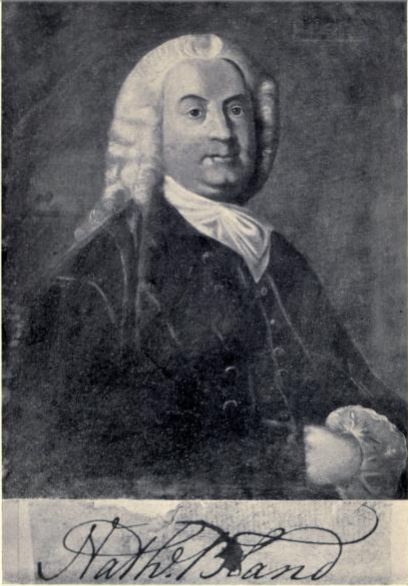
“The estate is said to have reached its zenith under the guidance of James Franklin Bland (1799-1863). His nephew the well known architect James Franklin Fuller described the castle estate in his
autobiography as a largely self-supporting community busy with sawmill, carpenter’s shop, forge as well as farming and gardening. A fish pond existed on the water’s edge just below the castle, alternatively described as being self-replenishing with the tide or restocked from a trawler.
“The castle itself consisted of a three-storey main block with a four-storey octagonal tower rising through the centre and a two storey partly curved wing branching off in a western direction. Major renovations were carried out and a significant additional wing running southwest, overlooking the coastline was added sometime between 1895 and 1904.
“James Franklin Bland’s death in 1863 the estate passed to his son Francis Christopher, the estate slipped into decline during the time that he was absent while travelling and preaching on Christian ministry, this being during the years of land agitation in Ireland. Part of the estate was sold in the landed estates court in 1873 but ultimately the decline continued with the remainder being sold in 1891.
“It was bought in 1891 for £30,000 by Colonel Charles Wallace Warden. He had retired in 1895 as Colonel of the Middlesex Regiment (previously known as the 57th) He had seen action in the Zulu War of 1879 and on his death on 9th March 1953 in his 98th year was its oldest survivor. He also fought with the Imperial Yeomanry in the Boer War. As landlord of Derryquin he was highly unpopular with tenants and neighbours alike, his behaviour regularly mentioned in Parliament. After the burning of Derryquin Castle he retired to Buckland-tout-Saints in Devon and acquired an estate there with his payment from the burning of Derryquin.
“However in 2014 Derryquin castle rose again out of the ashes to feature in a novel by Christopher Bland chairman of the BBC who having discovered a photo of his ancestors decided to write the novel Ashes in the Wind. it interweaves the destinies of two families: the Anglo-Irish Burkes and the Catholic Irish Sullivans, beginning in 1919 with a shocking murder and the burning of the Burkes’ ancestral castle in Kerry. Childhood friends John Burke and Tomas Sullivan will find themselves on opposite sides of an armed struggle that engulfs Ireland. Only 60 years later will the triumphant and redemptive finale of this enthralling story be played out.“
Whole House Rental County Kerry:
1. Ballywilliam House, Kinsale, County Kerry – whole house rental, up to 16
8 bedrooms. Minimum 14 nights stay.
2. Barrow House, Barrow West, Ardfert, Tralee, Kerry, V92 Y270
See above, https://www.barrowhouse.ie/ and “We invite you to celebrate, reconnect and escape with your friends and family to the idyllic West Coast of Ireland. Enjoy the benefits of exclusivity, privacy and tranquillity and make Barrow House your home. Unwind and relax as you enjoy a smouldering fire, or explore the lakes and mountains of our great outdoors. Our aim is to provide a beautiful backdrop steeped in rich history for you and your companions to create lingering memories. Your stay will be uniquely tailored to your preferences, choose your own pace of life, making it as restful or as active as you please.“
3. Churchtown House, Killarney, County Kerry (sleeps 12)
Mark Bence-Jones tells us (1988):
p. 83. “(Magill/IFR) A three storey 5 bay C18 house. Doorcase with entablature on console brackets flanked by narrow windows. Fine gate piers with pineapples.” [4]
The Hidden Ireland website tells us:
“Churchtown Estate incorporates both Churchtown House and Beaufort Golf Club. The centre piece is the Georgian Churchtown House built in 1740 by Sir Rowland Blennerhassett. In 1860 James MacGillycuddy Magill bought the estate and turned it into one of the largest dairy farms of its time in the south west region.
“James’s grandson and great grandson’s closed the farm in the early nineties and with the help of golf architect Arthur Spring, developed Beaufort Golf Course which was officially opened in 1995. The golf course went through further development in 2007 when it was re-designed by Tom Mackenzie of Mackenzie Ebert – Leading International Golf Architects.
“Churchtown House mixes traditional elegance with country house charm and modern facilities. 2 large elegant reception rooms, roaring fires and quiet reading rooms add to the atmosphere. There is also a home entertainment room and games room in the basement of the house for guests to enjoy.
“The House comfortably sleeps 12 in 6 spacious bedrooms, with a selection of King or twin rooms, with 2 additional ‘pull out’ beds if needed to accommodate 14 guests. All bedrooms have private bathrooms with modern facilities. The kitchen is fully equipped with an Aga and halogen hob, modern appliances and beautiful breakfast table looking out onto the courtyard and Ireland’s highest mountain Carrauntoohil.
“The ruins of 15th century Castle Corr standing on the 15th green was designed as a square tower house. Castle Corr (Castle of the round hill) was built circa 1480 by the MacGillycuddy’s, a branch of the O’Sullivan Mór Clan. Fearing that it would have been taken by the English forces Donagh MacGillycuddy burnt the castle in 1641 but restored it in 1660. Donagh went on to become High Sheriff of Kerry in 1687.
“The castle was abandoned by Donagh’s son Denis in 1696 when he married into the Blennerhassett family in nearby Killorglin Castle. The stone of Castle Corr was taken to build the Georgian manor Churchtown House.“
4. Coolclogher House, Killarney, County Kerry – whole house rental accommodation, up to 16 people

“Coolclogher House built in 1746 is a historic manor house set on a 68 acre walled estate near Killarney on the Ring of Kerry. The house has been restored to an exceptional standard by Mary and Maurice Harnett and has spacious reception rooms, a large conservatory containing a 170 year-old specimen camellia and seven large luxurious bedrooms, each with their own bathroom and with magnificent views over the gardens and pasture to the dramatic mountains of the Killarney National Park.
“This is an excellent base for exploring this ruggedly beautiful county and Coolclogher House specialises in vacation rental for groups of up to 16 people. It is right on the Ring of Kerry and Ross Castle and Killarney town are within walking distance while the Gap of Dunloe and Muckross House are in easy reach. It is the ideal special holiday destination for extended family groups, golfing groups or celebrating that special occasion.
“The famous Lakes of Killarney, the Killarney National Park, Muckross House and Abbey and Ross Castle are all within easy reach. Killarney is an ideal starting point on the famous Ring of Kerry, going by way of Kenmare, Parknasilla and Waterville, and returning via Cahirciveen, Glenbeigh and Killorglin, but there are also wonderful drives through Beaufort and the Gap of Dunloe, along Caragh Lake to Glencar or, for the more ambitious, a day trip to the Dingle Peninsula or the wonderful Ring of Beara. There are world famous golf courses at Waterville, Tralee and Ballybunion while boat trips on the famous Lakes of Killarney, fishing and horse riding can all be arranged.
“Situated 5 minutes from the historic town of Killarney, which boasts a number of excellent dining options and a wide variety of entertainment, this mansion house is the perfect base for a longer stay and a wonderful location for a family reunion or for celebrating a special occasion.“
[1] https://www.irelandscontentpool.com/en
[3] https://www.ihh.ie/index.cfm/houses/house/name/Tarbet%20House
[4] Bence-Jones, Mark. A Guide to Irish Country Houses (originally published as Burke’s Guide to Country Houses volume 1 Ireland by Burke’s Peerage Ltd. 1978); Revised edition 1988 Constable and Company Ltd, London.
Text © Jennifer Winder-Baggot, www.irishhistorichouses.com